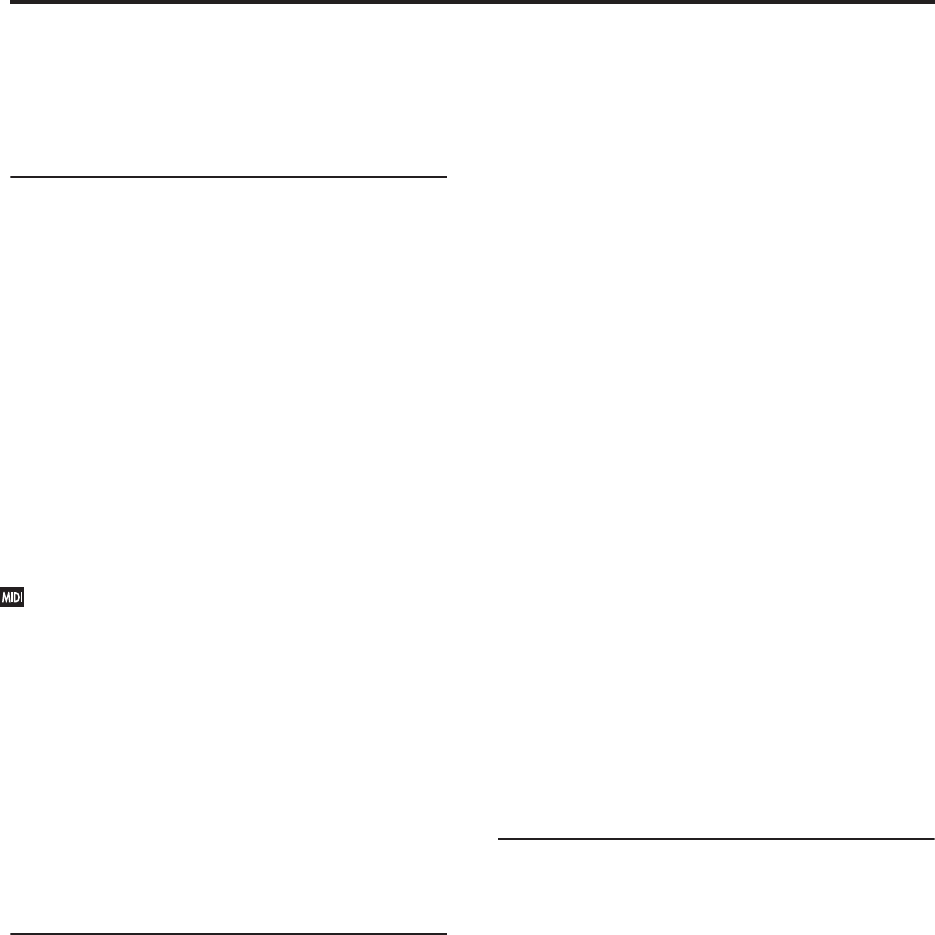
EXi: MS-20EX
288
TRANSPOSE [-24.00…+24.00]
This controls the coarse tuning, in half-steps and cents,
up or down two octaves. You can modulate this
smoothly via AMS.
4-1e: PAN & ANALOG
PAN [Random, L001…C064…R127]
This controls the stereo pan of the MS-20EX, at the very
end of the signal chain. A setting of L001 places the
sound at the far left, C064 in the center, and R127 to the
far right.
When this is set to Random, the pan position will be
different for each note-on.
You can also set this Pan parameter directly from the
Control Surface knobs. To do so:
1. Press the Control Surface Timbre/Track button.
2. Set the MIXER KNOBS switch to INDIVIDUAL
PAN.
3. Move Knob 1 to set the pan for EXi 1, and Knob 2
to set the pan for EXi 2.
You can also control pan via MIDI Pan (CC#10). A
CC#10 value of 0 or 1 places the sound at the far
left, 64 places the sound at the location specified by
the “Pan” parameter, and 127 places the sound at
the far right.
Note: you can select Random pan only from the on-
screen UI, and not from AMS, MIDI or the Control
surface.
ANALOG [0.00…10.00]
This models the instability of an analog system by
adding subtle randomization to the VCO and VCF
frequencies.
This parameter is not modulatable.
4-1f: Parameter Details
When you touch a knob, a yellow square appears
around it, showing that it has been selected.
This area shows details for the selected knob, including
its parameter group and parameter name, its exact
value, and its AMS assignments.
Individual parameters and AMS
The BEND RANGE and ANALOG parameters are not
modulatable. VCO1/2 WAVE FORM, VCO 1/2
SCALE, and PAN have only one AMS source and
Intensity, without Intensity Modulation. The rest of the
parameters on this page can be modulated by two
AMS sources, as described below.
(Parameter group)
This shows the group of the parameter (such as VCO
MIXER).
(Parameter name) [range depends on parameter]
This shows the name and exact value of the parameter.
You can edit the parameter value with any of the
standard data-entry controls.
AMS [List of AMS Sources]
This selects a modulation source to control the selected
parameter. For a list of AMS sources, see “AMS
(Alternate Modulation Source) List” on page 967.
Intensity [range depends on parameter]
This controls the depth and direction of the AMS
modulation. For unipolar parameters, the range is the
same as that of the selected parameter, in both positive
and negative directions. For instance, if the parameter
range is 0.00…10.00, the Intensity range will be -
10.00…+10.00.
For bipolar parameters, including VCO 2 PITCH,
FINE TUNE, TRANSPOSE, and MIXERS 1 & 2
LEVELS A & B, the range is twice that of the original
parameter. For instance, if the original parameter range
is -12.00…+12.00, the Intensity range will be -
24.00…+24.00. This allows full modulation of the
parameter, regardless of the initial setting.
In some cases, you can use AMS to modulate the
parameter outside of its original range, for a wider
range of values.
Int. Mod AMS [List of AMS Sources]
You can modulate the main AMS Intensity from
another AMS source. This selects that source.
For a list of AMS sources, see “AMS (Alternate
Modulation Source) List” on page 967.
Intensity [range depends on parameter]
This controls the depth and direction of the Intensity
Mod AMS. The result is summed with the main AMS
Intensity to produce the final modulation amount.
▼ 4–1: Page Menu Commands
The number before each command shows its ENTER +
number-key shortcut. For more information on these
shortcuts, see “ENTER + 0-9: shortcuts for menu
commands” on page 138.
• 0: Write Program. For more information, see “Write
Program” on page 138.
• 1: Exclusive Solo. For more information, see
“Exclusive Solo” on page 138.


















